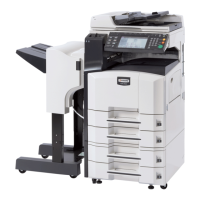ADVANCED OPERATION GUIDE Appendix-3
Choosing the Appropriate Paper
This section describes guidelines for choosing paper.
Condition
Avoid using paper with bent corners or that is curled, dirty, or torn. Do not
use paper that has a rough surface or paper fiber lint, or that is especially
delicate. Use of paper in any of these conditions will not only deliver poor
copies but may also cause jams and shorten the useful life of the machine.
Choose paper with a smooth and even surface; however, avoid coated
paper or paper with a treated surface as it may damage the drum or fusing
unit.
Ingredient
Do not use paper such as paper that has been coated or surface-treated
or paper that contains plastic or carbon. These paper may produce harmful
fumes from the heat of printing and may damage the drum.
Be sure to use the standard paper that contains at least 80% pulp, i.e., not
more than 20% of the total paper content consists of cotton or other fibers.
Supported Paper Sizes
Paper of the following sizes is supported by the machine.
Measurements in the table take into account a ±0.7 mm dimensional
accuracy for length and width. Corner angles must be 90° ± 0.2°.
Multi Purpose Tray
Cassette or Multi
Purpose Tray
A6-R (105 × 148 mm) A3 (297 × 420 mm)
B6-R (128 × 182 mm) B4 (257 × 364 mm)
Hagaki (100×148mm) A4 (297 × 210 mm)
Oufuku Hagaki (148 × 200 mm) A4-R (210 × 297 mm)
Executive (7 1/4 ×10 1/2") B5 (257 × 182 mm)
Envelope DL (110 × 220 mm) B5-R (182 × 257 mm)
Envelope C5 (162 × 229mm) A5-R (148 × 210 mm)
Envelope C4 (229 × 324mm) Folio (210 × 330 mm)
ISO B5 (176 × 250 mm) Ledger
Envelope #10 (Commercial #10) (4 1/8 × 9 1/2")
Legal
Envelope #9 (Commercial #9) (3 7/8 × 8 7/8")
Letter
Envelope #6 (Commercial #6 3/4) (3 5/8 × 6 1/2")
Letter-R
Envelope Monarch (3 7/8 ×7 1/2") Statement-R

